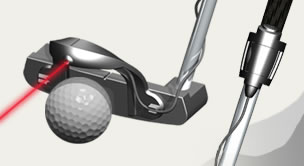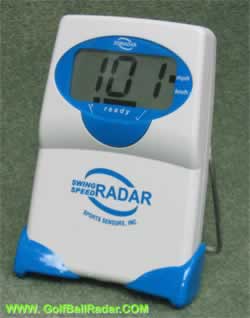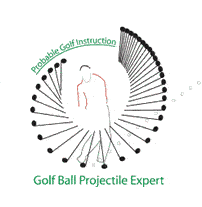
|
|
Golf Putting TipsLet's say you are a 19 handicap and you set a goal of becoming a 9 handicap by the end of the season (a very lofty goal, but possible). In my earlier newsletters on Statistical Analysis of an Average Golfer, for all levels of players, the most signficant way to lower scores is by improving the short game. Recall that: Compared to overall average golfer statistics, you need to improve by: † increasing
GIR from 3 to 8 (267%
increase) Your ball striking and thus swing would need to improve immensely to reach your goal. Imagine how much less improvement is necessary with the short game to realize lower scores. I recommend you buying Dave Pelz's book to help out. As some objectives to achieve this goal, I would highly recommend the 19 handicap putting some things in place to improve the short game such as: † arranging
some lessons from
a local professional For improvement to take place, of course, one needs to set aside ample time to practice and play. The 19 handicap won't improve much if all he/she does is play a round of golf 3 times each week. When top professionals make significant changes to their games, they often play less and practice more. It's difficult to work on improvement of various aspects of the game on the course because the sole goal there is score.
After only a few days of practicing my alignment with the laser device attached, I am now squaring the putter face to my target consistently. I can now practice making a proper stroke confident that I am aimed at my target. I am missing my putts a little right now, but am confident that I will "cure" my cut stroke. Take a look at the Laser Putting Device that I use and consider getting one for yourself Order yours TODAY! Only $49.95 This section of the site is about improving your putting, which is as outlined above the most effective way of lowering your score. Even if you're a scratch player shooting par, almost half of your strokes are putts. To improve your putting, you can improve in one or more of the following areas: 1. Stroke Mechanics: There are some fundamentals essential to good putting. 2. Feel: No matter how flawless your stroke, you must develop good kinesthetic feel to stroke putts the correct distance. 3. Reading Greens: With a sound stroke and great feel, you still need to be able to read how much a putt will break. Track your real putting statistics with a spreadsheet I've developed. You input not only how many putts you've had, but how long they are, thus giving your a much more realistic, useful statistic. One day you may have 26 putts, the next day you may have 32 putts. You may have actually putted better on the 32 putt day (the 26 putt days may have been the result of many short putts; you chipped really well that day). Putting Analysis Software -- Your Real Putting Handicap $9.99
The first two areas require athletic moves that can be improved upon through practice (some tips on those later). But, the third area, reading greens, can be improved upon by anyone. That's what I'll focus on teaching you now. Please complete this Golf Handicap Improvement Survey 
By analyzing how a ball is affected by the slope of the green and by the frictional resistance of the grass, I have determined how the plumb bob distance (between shaft and hole) is related to the amount of break. Most of the breaking occurs in the last few feet of roll. A typical 20 foot putt which breaks slightly because of a small slope would look like: 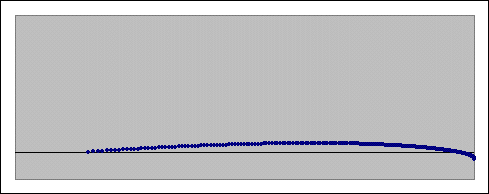 The horizontal
line in the picture is the imaginary line connecting you, the
ball and the hole. The first point on the left of the picture
is the starting position of the ball. The last point on the
right of the picture is the ending point of the ball if the
there were no hole. Where the path of the ball intersects the
imaginary line is the location of the hole. To maximize the
number of putts holed, one wants the speed of the ball to be
enough so that ball would move about 18 inches past the hole
if the hole were not there (as per Dave
Pelz's famous research).
Note
that the ball ends up farthest from the imaginary line about
7/12 of the way to the hole (about 11.5 ft for a 20 ft putt).
I'll refer to this position of a putt as the transition point.
It then crosses the imaginary line (at the hole) in the
remaining 5/12 of the way to the hole (about 8.3 ft). Thus most
of the break occurs in the last half of the distance (or 10
ft for a 20 ft putt).
A typical
20 foot putt which breaks a lot because of a large slope would
look like:
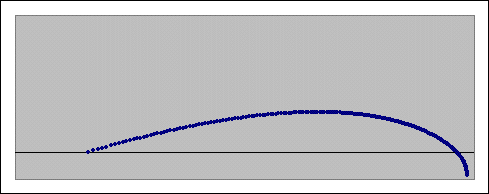 In this case, the putt breaks a lot more. In fact, there is even a larger percentage of break in the last half of the distance traveled. The transition point is about 8/12 of the way to the hole (or about 13.3 ft for a 20 ft putt). I have found that the transition point depends on the slope of the green, the speed of the green and the length of the putt. Thus if a putt plumb bobs 4 inches left of the hole, the amount of break and thus the amount one should aim left or the hole isn't the same for every putt. A long putt on a fast, high sloped green would break more than a shorter putt on a slow, low sloped green. Using physics & math, I have modelled how a putt breaks. I have developed a matrix that tells the golfer how much a putt breaks dependent upon the plumb read, the length of the putt and the speed of the putt. You can order my plumbing procedure and matrix here Order for $15.99 or you can purchase the putting procedure, reading and playing the wind & reading and playing elevation changes for $29.99 by clicking here Order. Go to my order page to see all of the products offered. Read testimonials from my past customers. For example here is part of my matrix for a medium speed putt: Medium Greens – Stimp meter reading = 10 feet
I've listed the values of my matrix of a medium sloped putt (1.0 degree of slope). These values are related to the plumb read which I explain along with the downloadable matrix. Note that for a long, 50 ft putt, the break is much greater relative to the read than a short, 6 ft putt. My full matrix includes slow paced and fast paced putts as well, which break different amounts but would have the same plumb read. I provide a service to golfers who are interested in determining how to read putts. If you'd like to purchase this service, in which I explain in detail how to plumb and use my "putting matrix" to translate the read into how much break, click the Order Services option. I'll send you the method I have developed. I'll provide you with information applicable for putting on slow, medium or fast greens. If you know the stimpmeter reading of your greens, you can send that information along and I'll provide you with precise information applicable to putting your greens. Keep your putting statistics. Get a free software program
which will track a calculate your real putting ability. Not
just how many putts you make per round, but what percentage
of various length putts you make and how many strokes it
takes from different distances. You can then compare yourself
to the pros and other handicap groups.
Plumb Bob & Reading Putts This
page deals how to read a putt given the slope of the green and using
a plumb bob. Reading putts for most golfers is real guess work.
Most golfers determine the amount of break of a putt from past experience.
Put the average golfer on a green he/she has never played before,
and the probability of the golfer reading the putt correctly would
be very low.
Most putts are under-read by golfers, even the professionals. I have developed a method to read putts using a plumb bob. Many would argue that plumb bobbing can only tell you which way a putt breaks, but not the amount. I was one of those people. But after analyzing the physics and mathematics of a breaking putt, I have determined a fairly simple procedure of taking what is learned from plumb-bobbing, and calculating the amount of break, which depends on the speed of the green and the length of the putt.
See and order all or my products at my golf product order page.
First
of all, how does one plumb bob. It's actually and very simple procedure
but is difficult to be accurate if you're not careful.
©Probable Golf Instruction, Ken Tannar 2001-2015. All Rights Reserved. Langley, B.C. V2Y 2G4 CanadaPhone: 604-309-7030 FAX: to fax, email an attachment probablegolf@yahoo.ca or golfexpert@probablegolfinstruction.com |
| GOLF ASSISTANTS |
|
Golf Trip Pairing CalculatorPlanning a golf trip with some friends/family? Trying to sort out the foursomes so people don't play too often with others? Order your ready made Spreadsheet. Type in the names, print out the groupings. Minimize repeat pairings.
Wind Caddy will advise you on aim, distance and club so that you can play the wind successfully. It takes the guess work out of club selection. New option to enter custom distances for each club. The algorithm will make a club suggestion accordingly. Use the right club in every condition!
|
|
|
| GOLF NEWS |
Golf Putting Green Reading Glasses |
| GOLF NEWSLETTER |
Statistics
·Putting
·Longest Golf Balls
·Games
·Handicap
·Scoring
·Shot Patterns
·Tournaments
·PGA Tour Stats
Pro Shop
·Ball Marker Engraved
·Books
·CDs & DVDs
·Green Reader
·Impact Labels
·Laser Rangefinder
·Longer Drives
·Products
·Teaching Aids
|
|
| GOLF POLL |
The 19th Hole
·Advertising
·Ask the Golf Expert
·Consultation/Litigation
·FAQs
·Golf Blog
·Golf Draws
·Links
·Science of Golf
·Tell a Friend
·Testimonials
·

Golf Ball Finder Glasses
Find all your errant golf balls and many more!
| GOLF TIPS |
How to play:
|
